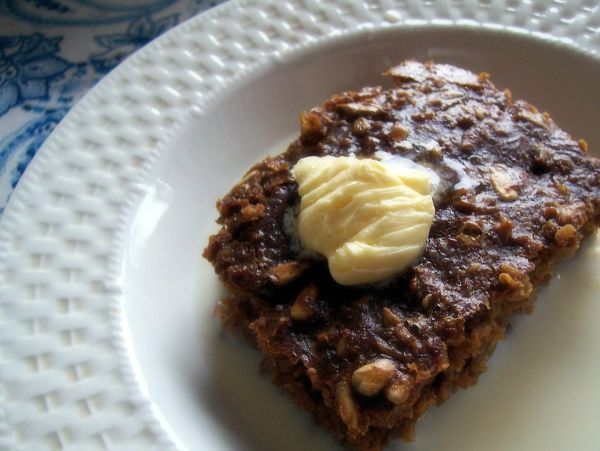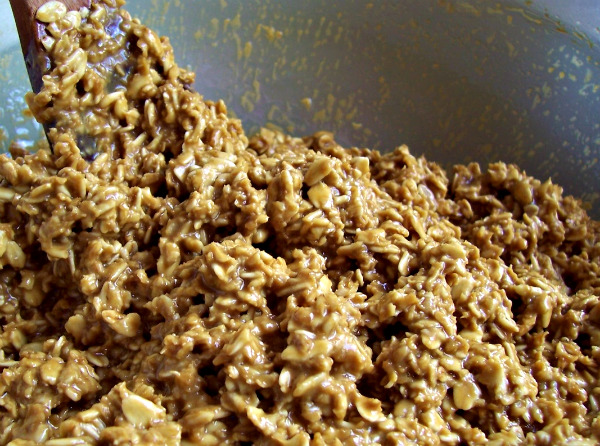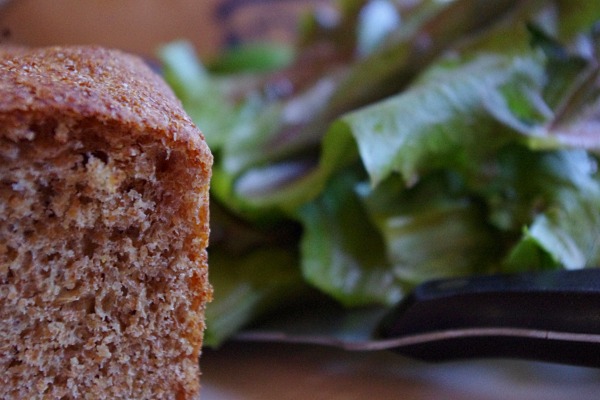Molasses-Sweetened Soaked Baked Oatmeal

I know it’s 90 degrees out there, but here I go again with another recipe to use up those fifty pounds of oats that you bought. Wait, that was me.
Whether you’ve got fifty pounds of rolled oats or five, you’re gonna want to try this recipe. It may be better suited for fall or winter, but since I finally recovered some photos of it on my computer I thought I’d share. Even in summer you can bake this on a cool morning and have breakfast for days.
In this recipe, the oatmeal is first soaked to reduce the phytic acid and make it more digestible. It is then combined with some of it’s closest friends – coconut oil, molasses, and cinnamon – to create a delicious, barely sweetened breakfast.
Molasses, while not super sweet, has great flavor as well as minerals. It is also really inexpensive at just over 80 cents per recipe for organic.
Served with whole milk yogurt or crumbled into a bowl of raw milk, it makes a hearty breakfast that can be eaten for days as it produces up to 12 servings.
Plus, it kind of tastes like cake.

Molasses-Sweetened Soaked Baked Oatmeal
Ingredients
- 6 cups old fashioned rolled oats
- 2 cups warm water
- 1/3 cup whey, yogurt, or buttermilk
- 1 cup melted coconut oil or butter
- 8 large eggs, beaten
- 1/2 cup molasses (not blackstrap)
- 2 teaspoons vanilla extract
- 1 tablespoon cinnamon
- 2 teaspoons baking soda
- 1 teaspoon sea salt
- 1/2 cup chopped walnuts
- 1/2 cup raisins (optional)
Directions
- Soak the oats: The morning before you want to make this for breakfast (~24 hours) combine the oats, warm water, whey/yogurt/buttermilk, and melted coconut oil or butter in a large bowl. Pat it down a little so that it is mostly one large "dough". Let sit in a warm place until the next morning.
- In the morning preheat the oven to 350 degrees. Place the bowl of soaking oats on top of the oven to warm up a bit while you butter a 9×13" baking pan.
- Combine eggs, molasses, vanilla, cinnamon, baking soda, and sea salt together in a medium-sized bowl. Stir this mixture into the oat mixture. You will have to use a wooden spoon to break up the oatmeal and evenly disburse the egg mixture.
- When the egg and oat mixtures have been combined, stir in the walnuts and raisins. Pour into the buttered pan and bake at 350 degrees for 30-35 minutes, or until a toothpick comes out clean.
- Serve warm with milk and additional nuts and raisins if desired. Serve cold with yogurt and additional honey if desired.


This recipe looks very delicious – cant wait to try it sometime soon!!!
Wow – this looks like a great variation on the baked oatmeal I usually make. Maybe I’ll add some ginger and cloves to give it a ginger-bread like flare.
I was wondering what your thoughts are on adding some flour during the soaking stage as I’ve heard it’s necessary to effectively neutralize the phytic acid. What do you think?
Susanna – You could absolutely add some flour. I have also read that a bit of wheat helps along the process. Maybe 1/4 cup would be sufficient.
I am unable to eat eggs, any idea how this would come out without them? Maybe I could do flax as a replacer?
Amy – I would try making a flax or chia gel and using that for the eggs. One egg = about 1/4 cup of liquid, so try that.
How does it keep? Have you tried to freeze any? Only my husband has eats grains right now, so if it kept and/or froze well this would be an awesome make ahead breakfast!
Ceitllyn – I keep it in the fridge for about five days at a time. You could also freeze individual slices and pull out and warm up as needed.
@Shannon,
Awesome, thanks! I am looking forward to making and freezing for wonderful weekend breakfasts.
Oh, this look incredibly delicious! I am going to soak the oats tonight and make it tomorrow morning. To make it baby friendly, I am going to grind the oats first into a flour and reconstitute the raisins so they are soft, also instead of molasses I will add these very ripe bananas. Do you have any other tips for making this a baby-friendly recipe? Also, why “not blackstrap” molasses? Thank you! I love your blog!
Laurie – I cited “not blackstrap” because I did not use it in recipe testing. Black strap has more minerals, but a stronger taste and it could certainly affect the flavor. I would give it a shot, though, just for the nutrients.
Why does the recipe say not to use blackstrap molassis? It looks really good.
Ann – I cited “not blackstrap” because I did not use it in recipe testing. Black strap has more minerals, but a stronger taste and it could certainly affect the flavor. I would give it a shot, though, just for the nutrients.
oh my goodness. this looks so good. Making this soon!!
Hi Shannon, just wondering — why not blackstrap molasses? (It’s all I have at home — wondering if I might just use it?). Thanks!
Kristin – I cited “not blackstrap” because I did not use it in recipe testing. Black strap has more minerals, but a stronger taste and it could certainly affect the flavor. I would give it a shot, though, just for the nutrients.
This looks delicious! The photo made me think of this oatmeal spice cake my mother used to make for Sabbath dessert… Mmm… I think I’m going to give it a try for breakfast this weekend.
I also was wondering about the “not blackstrap” caveat – is it because it’s not sweet enough, or is there something icky about it I don’t know yet? 🙂 I have 5 gallons of organic blackstrap, so I’m pretty much stuck using it no matter what. 🙂
Meg – I cited “not blackstrap” because I did not use it in recipe testing. Black strap has more minerals, but a stronger taste and it could certainly affect the flavor. I would give it a shot, though, just for the nutrients.
… I think that picture overloaded the part of my brain that deals with taste. I’m having trouble thinking of something to say that is more detailed than “WANT.”
And it makes 12 servings? Sounds like student food to me! I’ll put it on the list of things to try in the fall.
Sounds delicious, but I don’t have any buttermilk or plain yogurt on hand – would it be ok to use vanilla yogurt?
Mariana – I would think so. Might make it a touch sweeter too :).
Shannon~
I love your style when it comes to repeat questions. Some bloggers spend alot of time with individual explanations, some ignore them in the hopes that the posters will read the first answer. Of course, if we don’t have time to read ALL comments the first time, we probably won’t later.
I think I catch a glimpse of your parenting style in this: firm yet patient. Just something to throw out there. Lol.
I made this on our family vacation and every one loved it. Thank you!
This looks so good – I can’t wait to make some. I wonder, though, how is it that the buttermilk, or yogurt can sit out for so long during the “soak”, and it not go bad where it’s inedible? Is it because of fermentation?
I wonder if there is a way to make this dairy-free?
Hi Shannon! I make a similar recipe (just larger for my larger family) but I mix all of the ingredients together about 24-48hrs before baking (1 child makes 2 mornings worth every week), keep them in the fridge and then just pop them in oven the morning we eat them. It turns out great, but I’ve wondered if it is as effective at reducing the phytic acid as a more traditional soaking… or something like your directions. Any thoughts?
Carolyn
HomesteadingFamily.com